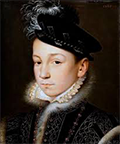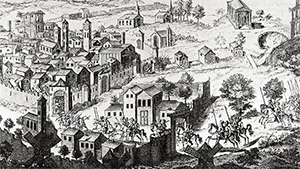The French King Charles IX
Charles IX was King of France during the latter half of the 16th Century. His short reign was noted for the political instability of his realm, particularly with regard to religious strife. 
He was born on June 27, 1550, in Saint-Germain-en-Laye. His father was the reigning monarch, King Henry II, and his mother was Catherine de Medici. Charles's older brother, Francis, became king when their father died, in 1559. Francis was on the throne for 18 months before he died, on Dec. 5, 1560. At that moment, Charles became King of France; he was 10. Catherine, as she had done with Francis, was regent. In fact, even when Charles had come of age, she had a hand in all relevant actions of government. As had his older brother before him, Charles suffered from ill health, in his case mental as well as physical. He reveled in the thrill and passion of the hunt. He was prone to sudden fits of violence, in one instance assaulting his own sister. At the same time, he was fond of poetry, even writing some of his own. In fact, he was the patron for Le Pléiade, a writers group. The conflict between Catholics and Huguenots, French Calvinists, worsened during Charles's reign. Things had begun to get out of hand during his father's reign, especially since Henry had issued edicts and enacted laws encouraging religious persecution. Francis II, in his short reign, continued these policies, which so angered Huguenots that they at one point attempted to kidnap the young king. That scheme, known as the Amboise Conspiracy, failed, and Francis ordered reprisals in the form of executions for dozens of leaders of the plot. Charles witnessed many of these executions. A 1561 religious conference known as the Colloquy of Poissy came to no real reconciliation. Catherine was a Catholic but wanted to keep the peace more than prosecute a religious vendetta. She had the government issue the Edict of Saint-Germain, in January 1562, granting some demands made by Huguenots. The response from the powerful Catholic Guise family, who had been the power behind Francis's throne, was to order a wholesale killing of Huguenots in Wassy on March 1. This came to be known as the Massacre of Wassy. Unsurprisingly, Huguenots took up arms against the government in response. Fighting raged across the realm for a number of months. Leaders on both sides, including Francis, the Duke of Guise, were killed. Catherine again stepped in, organizing a truce in March of 1563. The peace held, and Charles and his mother embarked on a tour of the realm. 
Religious violence flared up in 1567. A number of Huguenots tried to capture the king and members of his family at Meaux. This plot, too, was foiled. Angry Huguenots in Nîmes killed Catholics on the Christian holiday of Michaelmas, an incident that came to be known as Michelade. More battles followed, and the king in 1568 declared another peace. Catholic militants unhappy with the terms of that peace resumed the fighting, and the war dragged on, this time involving forces from England, Navarre, Spain, and Tuscany. The king married in 1570, to Elisabeth of Austria; they had a daughter, Marie Elisabeth of Valois. In that same year came the Peace of Saint-Germain-en-Laye, after which Charles increasingly took advice from Admiral Gaspar de Coligny, a Huguenot leader. An effort at peace involved the marriage of the king's sister Margaret to Henry of Navarre. A week after the wedding, in August 1572, the Duke of Guise killed Coligny. The violence that followed last five days. Catholics by the thousands targeted Huguenots by the thousands, in what came to be called the St. Bartholomew's Day massacre. Estimates of the dead range widely, from a few thousand to tens of thousands. Huguenots responded again with warfare, and Catholics joined in the fray. Charles in 1573 issued the Edict of Boulogne, which granted religious freedom and amnesty to the Huguenots living in France. The violence continued off and on for months. Charles had suffered from ill health his entire life. He is thought to have contracted tuberculosis and by early 1574 was in very bad shape. He died on May 30; his younger brother, Henry, had been elected King of Poland and so couldn't return right away. Their mother, Catherine, remained as regent. Henry did return eventually and was crowned King Henry III. |
|
Social Studies for Kids
copyright 2002–2026
David White




